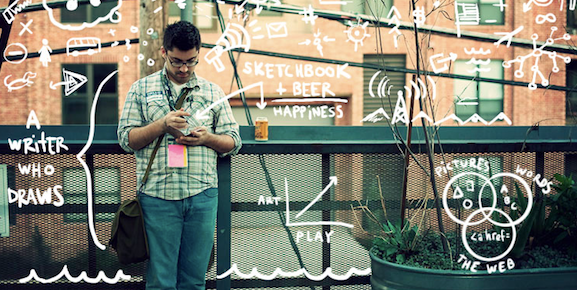I was browsing through The Metro – a UK commuter paper – a few weeks ago and came across this article by Ross McGuinness discussing whether or not doodling helps to focus the mind and make us more productive. I remember being told off by my teachers for doodling in class and constantly try to refrain from doing it when I’m thinking during meetings in the office, but should we be discouraging the doodlers in our team or is there more than boredom to their scrawls and pretty pictures?
Obviously as I’m part of a company which creates software rooted in visual techniques, I’m interested in understanding the benefits of any kind of visualisation, including doodles. It’s this premise which sparked off the birth of Mindjet. Our founder Mike Jetter knew from experience that using visual ways of working, such as mind maps, was more efficient and as such, created Mindjet.
According to this post on the Counselling Directory website, creative geniuses such as Sylvia Plath, Leonardo da Vinci and Mark Twain often let their imaginations run wild in a scrawl of messy doodles while contemplating future masterpieces. Such celebrated artists can’t be wrong, surely?
In his article Ross McGuiness highlights various studies which have been carried out over the last few years to figure out the power of the doodle. In 2009 research conducted by Jackie Andrade (professor of psychology at Plymouth University) revealed that doodling increases our attention span during meetings. The study also showed an increased power of recollection by those who doodled compared to those who did not. Other studies have found that doodling can even help those suffering with attention deficit-hyperactivity disorder (ADHD) as a way of keeping their minds focused.
We actually conducted our own investigation into the benefits of visuals last year, which showed that if data is displayed in this way, such as in mind maps, individuals in an office environment are 17% more productive and need to use 20% less mental resources. What’s more, teams collaborating on a joint project use 10% less mental resources and are a whole 8% more productive when using visualisation tools. You can read more about the experiment here.
Here at Mindjet we’re always embracing change and ways to inspire ourselves and our colleagues. We’ve even implemented a “Work Inspired” manifesto, which you might have seen otherwise you can read it here. From now on I think I’ll encourage the team to be less judgemental about anyone seen doodling during meetings!
Dig this article? You might also enjoy: “Visualization is Genius, Not Juvenile”

